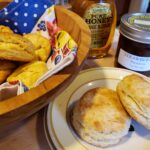Some Buzz on Springtime
By Frank Whitman
Spring is, among other things, bee season. You’ve heard of the birds and the bees, right? Well, as flowers blossom, they need bees and the bees need them. It’s the kind of perfect matchup that occurs all the time in nature. The beekeeper in our neighborhood is busy setting out hives, prepping for the spring rush of honey making.
Honey, like wine, has terroir. The character of the flowers patronized by the bees comes through in the flavor and color of the honey. Orange, blueberry, buckwheat, linden, (rare) tupelo and more, each distinctive variety, harvested through the seasons as they flower, has its own palate. Even the more generic designations – like wildflower or clover – have a sense of place and evoke meadows carpeted with native plants.
If you ever get a chance to visit a honey tasting bar, take it! The range of flavors is eye-opening. These places are usually found in tourist areas along with olive oil tasting stores and T-shirt shops. We’ve tasted on Monterey’s Fisherman’s Wharf, at Hilton Head Island, and in Athens, Greece. Each experience was a flavorful glimpse into the local ecology.
There’s a trend these days to have a few hives in the backyard for hyper-local honey. It’s a fascinating DIY hobby, but professional beekeepers can be engaged for a less hands-on experience. Our Congressman, Jim Himes, is a honey hobbyist with a few hives at his Cos Cob house.
Let’s talk for a minute about the technical stuff. Honey can be either raw or pasteurized. Raw honey has been strained to get rid of chunky bits of natural trash but is otherwise as it came from the hive. Pasteurized honey has been heated, resulting in longer shelf life and a clearer product, but removes some of the healthy natural ingredients.
Fermented honey (which is popping up on restaurant menus) is made by adding a little water and letting raw honey naturally ferment. It intensifies flavors without making alcohol (that’s mead); makes honey looser and easier to mix; and is a way to infuse other flavors like garlic or cranberries.
 While we’re at it, let’s acknowledge the health benefits of honey and then move on. Honey, particularly raw, has antioxidants and minerals that are good for you. But even without those components, I like it for its taste and sense of place. Honey, unlike sugar, adds more than sweetness – it adds flavor.
While we’re at it, let’s acknowledge the health benefits of honey and then move on. Honey, particularly raw, has antioxidants and minerals that are good for you. But even without those components, I like it for its taste and sense of place. Honey, unlike sugar, adds more than sweetness – it adds flavor.
We’re lucky to have close by beekeepers like Morell Apiaries of Preston, CT so we can find local honey on the supermarket shelves and at farm market stands. I’ve even seen some from Manhattan neighborhoods.
For a more regional, but still All-American approach, The Local Hive Company is producing regional raw, unfiltered honeys, like wine from Napa as opposed to a specific vineyard. Regional bottlings include  close-to-home blends: Northeast (with a slight tang that was a good fit for some improvised Chicken Marbella) and New England (smoother, great for a hot toddy). But if you want to send a local bottle to someone far away, they also supply blends from Texas, Florida, Great Lakes, Midwest, Oregon, Rocky Mountain and more.
close-to-home blends: Northeast (with a slight tang that was a good fit for some improvised Chicken Marbella) and New England (smoother, great for a hot toddy). But if you want to send a local bottle to someone far away, they also supply blends from Texas, Florida, Great Lakes, Midwest, Oregon, Rocky Mountain and more.
Honey drizzled on a warm, buttered biscuit can’t be beat. But honey is a natural food partner that fits in almost anywhere. I put a spoonful in the jar of vinaigrette we keep on the counter. Honey can be a foil to the tangy flavors in barbecue sauce or mustard. It can be used to round out sauces and soups, paired with salty cheeses, or drizzled on
vegetables for roasting. Hot Honey, seasoned with incendiary peppers, has become a cult item in recent years.
Honey is fundamental to a warming winter toddy, but in summer it’s refreshing in a Bee’s Knees cocktail.
Stickiness is the downside of honey. I sometimes feel as though my fingers get sticky even if a jar is opened on the other side of the room. I’m trying to embrace this perceived flaw. The answer is to relax, lick my fingers and enjoy the extra connection with the hard-working bees.
















No Comment